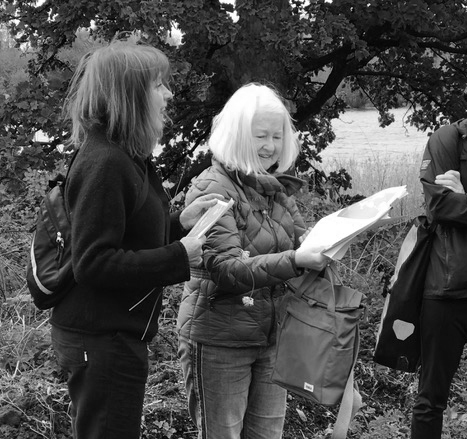
Conversations in a Garden:
A Year of Wonder and Well-being
Continued…
“At that time we had no particular intention of exploring spiritual matters in the context of the garden,” Brigid and Christine have reflected. “But neither was our intention to create either botanical illustration or descriptive poetry. As time went on we sensed that, alongside the growth that we were witnessing in the garden, a deepening of our mutual engagement with the natural world was underway. Realising that our collaboration had a contemplative dimension we began to understand that, perhaps, we could create something that might help others to experience what we were experiencing there: a ‘dusting off of the eyes’ which was allowing us to see more deeply and to notice in ourselves a burgeoning ‘felt sense’ of what could be viewed as a spiritual as much as a physical reality.”
Brigid spent many hours and in all weathers drawing and painting ‘en plein air’, then sharing her work with Christine. Occasionally a poem of Christine’s would inspire Brigid to paint a particular plant but, more generally, the visual work appeared to be acting as a stimulus for the poems. Such is the nature of ekphrasis. An ekphrastic poem is, according to The Poetry Foundation, a vivid description of a scene or, more commonly, a work of art. They continue:
“In this context, we began to change and our consciousness to shift as, often in surprising ways, our appreciation expanded rapidly: for example, our appreciation of wonder; of peace; of how plants thrive best; of the complex harmonies in the natural world as symbiotic relationships; of the arbitrary designation of ‘weeds’; of the incomer and making room for the non-indigenous; of animal, vegetable, mineral and fungal harmony; of birds and other species as an integral part of the garden; of the nature of beauty through the seasons of life; of nature as consoler and inspiriter in difficult times; of the power of symbols to stir spiritual response and, eventually, of an emerging sense of wholeness. That the macrocosm is so reflected in the microcosm was made abundantly clear to us as these shifts occurred in each of us, often subtly, sometimes with a feeling of immensity.”
What follows here is a series of drawings and paintings and poems that may be seen not only to be exploring a range of ideas but each of which invoked in artist and poet, as those who gave them shape in these forms, a deep sense of gratitude: “We learned so much in the garden, all of which increased our appreciation of the natural world, and our place in it.”
“I think one of the ways, the only way actually, that we will save the planet is by falling in love with it, by realising how incredibly beautiful the complexity of it is.”
– Brian Eno (2020)
Christine writes: “Deeply focused as we were on what was all around us, and insulated for a short while from the barrage of news and views, perhaps what we experienced there were momentary states of grace,” akin to what poet, William Wordsworth (1770-1850) described as ‘spots of time’: small, but memorable events, occurring mainly outdoors and when one is in touch with nature, these ‘spots’ have a lasting quality, according to Wordsworth, capable of “lifting us up when we are fallen”. Such states connect us to our own essential nature, feel transformative and, by kindling a spirit of care and commitment for the whole planet, can lead towards an awareness of the interdependence of all things. As Brigid observes: “Our understanding of the interconnection between love of the natural world, of which we are a part, mixed with the wonder of it and the inspiration of art with what is numinous seemed to grow in this place, moment by moment.”
“Whether imagined or real, gardens as refuges signify peace, comfort, freedom and hope, and are sites of pleasure, contentment, “spirituality and sanity”
– Where birds felt louder: The garden as a refuge during COVID-19, in Wellbeing, Space and Society, Volume 2, 2021
During their time there (July 2021-July 2022) Brigid and Christine created, together, in the garden:
- A series of artworks, all created working ‘en plein air’, in the form of studies in watercolour, initially and then using chalk pastels, several of which have been further developed as a series of ‘pages’ from a notional Book of Hours;
- A series of ‘ekphrastic’ poems written by Christine in response to Brigid’s drawings and paintings of the plants and plant communities – poems which necessarily also reflect Christine’s personal response to the garden;
- A short film introducing the collaborative work between Brigid and Christine in the context of Dr Neil’s Garden, Duddingston;
- A series of Meditations, reflections on our collaborative work, written by Dr. Kitty Wheater, Mindfulness Chaplain at the University of Edinburgh;
- An exhibition, “Of Mutual Things…” at Thomson’s Tower (19th-26th June, 2022).
In these Meditations, Kitty reflects:
“Christine is picking up on something subtle in Brigid’s pastel(s): the texture gives way…to space and air…” creating “a shift in mood that Christine’s words echo. The garden is right here, and precious for it, they seem to say – and, too, it reaches out to the great and spacious whole of which it is inextricably part. There is a wonder in this, and the sense of how that seam of love of place gives rise to a love of all place; how the dedication and attention to the micro places love at the heart of the macro.
With dedication and attention come, in turn, both soberness and hope.” Like art, “love is a practice…and it is a practice embedded in time. It is commitment to the possibility of a future we cannot yet foresee, and mysteries we cannot yet understand, wrapped in that entangled private …world. In commitment, there is surrender to plants, who they are, and all that they unknowably hold.”
– Dr. Kitty Wheater, Mindfulness Chaplain, University of Edinburgh





